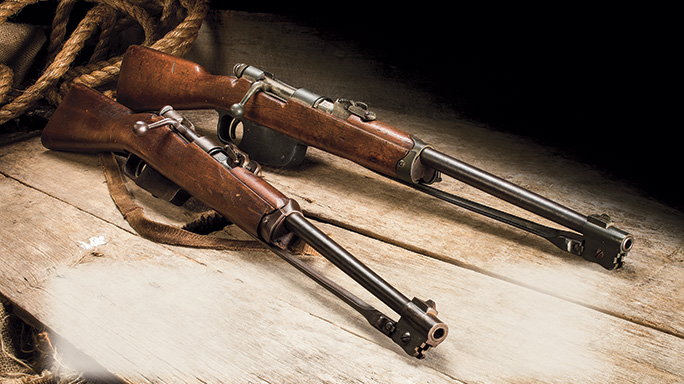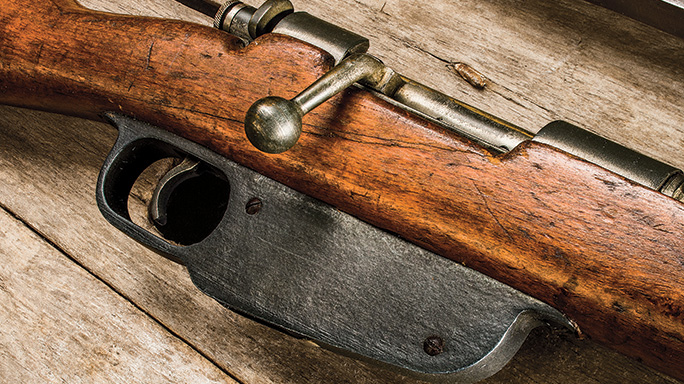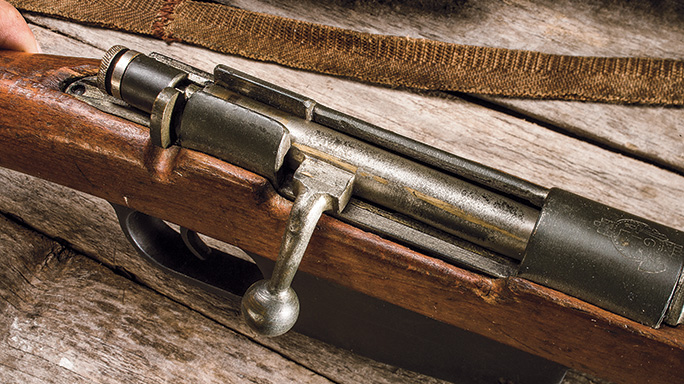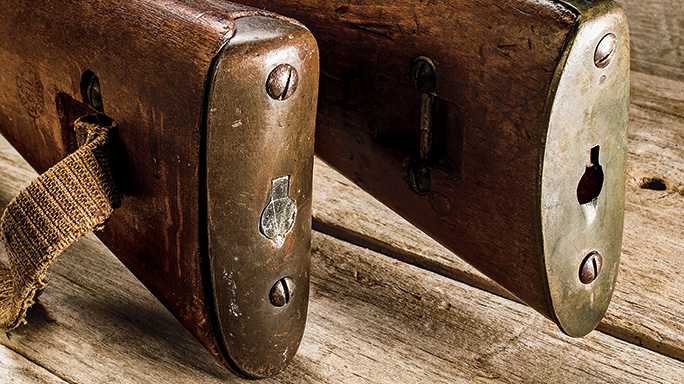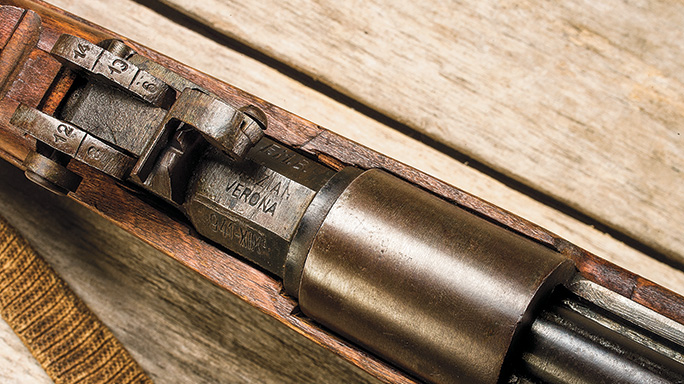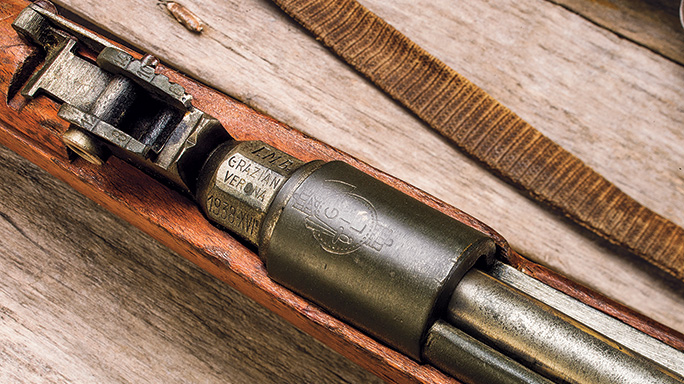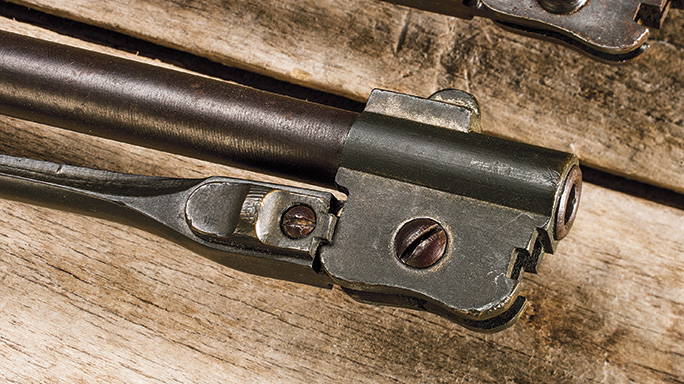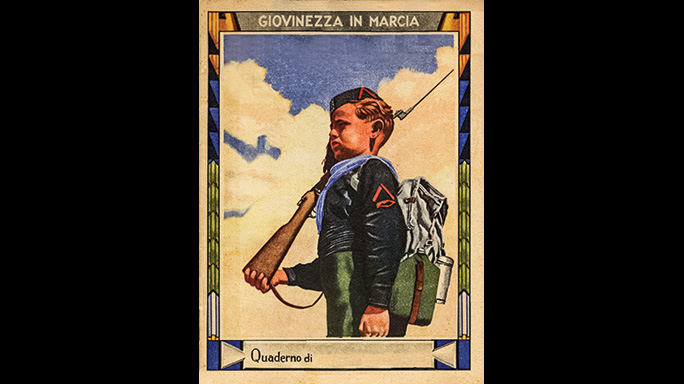Clearly inspired by Rome’s ancient glory and military achievements, Mussolini and the fascists did little to conceal their dreams of expansion and empire for Italy. In order to realize these nationalistic aims, militarization of Italian society was necessary, and particular emphasis was placed on indoctrination of the country’s youth.
- RELATED STORY: 8 Rimfire Replicas of History’s Greatest Battle Weapons
To this end, in 1926, after barely four years in power and following Mussolini’s expressed desire to provide pre-military training and to arm Italian youths beginning at a very young age, the fascists established the Opera Nazionale Balilla (ONB) youth organization. The term “Balilla” evoked the memory of a young boy, Giovan Battista Perasso, whose nickname was Balilla, who on December 5, 1746, touched off a popular revolt against the Hapsburg occupiers in Genoa. By December 10, the revolt had managed to free the city from
the Austrian troops.
The ONB program encompassed boys from six to 18 years of age, organized along military lines, who, depending on their age group, were issued uniforms and weapons of various types ranging from strictly toy weapons to light machine guns. In October 1937, the ONB was replaced by the Gioventù Italiana del Littorio (GIL), which was disbanded in July 1943.
Advertisement — Continue Reading Below
Training Carbine
In 1931, in response to a request by the ONB, production began of a very faithful blank-firing copy approximately four-fifths the size of the corresponding full-size Carcano moschetto modello 1891, commonly (although actually improperly) referred to as the cavalry carbine both in Italian as well as in English. This carbine was designated the moschetto regolamentare Balilla modello 1891 ridotto (reduced size Model 1891 Balilla regulation carbine) and was also referred to as the moschetto per ONB, or more commonly as the moschetto Balilla. It was ultimately designed to familiarize young boys with the regulation Carcano battle rifle and its proper handling.
Three different firms were associated with the manufacture of the Balilla blank-firing carbines: Napoleone & Vittorio Castelli (usually referred to as Castelli), Fabbrica Nazionale d’Armi-Brescia (more commonly referred to as FNA-B, or simply FNA), and Fratelli Grazian (Grazian Brothers). Information concerning production by Castelli is far from clear, as is its relationship to FNA, as will be addressed later. The origins of the third manufacturer, Fratelli Grazian of Verona, are also surrounded by some element of mystery. It appears that Fratelli Grazian, unlike Castelli and FNA which were established firearms manufacturers, was formed specifically for the manufacture of the Balilla carbine. There are no known records indicating that Grazian engaged in any type of manufacturing either prior to or subsequent to its production of the Balilla.
Advertisement — Continue Reading Below
In all respects, the Balilla is a very faithful reduced-scale version of the regulation Carcano cavalry carbine. The regulation weapon has an overall length of 36.2 inches, while the Balilla’s length typically is 29.5 inches, although there are very slight variations in length depending on the manufacturer. Similarly, the regulation carbine weighs in at around 7 pounds, or a few ounces more depending on the type of wood used, while the Balillas weigh between 3.5 to 4 pounds depending on the manufacturer.
The Balilla carbines produced by FNA and Castelli were almost identical; Grazian produced two distinct versions of the Balilla, the first of which differed noticeably from the FNA and Castelli type, while the second version was almost identical to those of the first two manufacturers. The forged and machined-split bridge receiver is an exact copy, in reduced scale, of the full-sized Carcano receiver. Two bolt variations can be encountered, as is true of regulation Carcano bolts. The underside of early Carcano bolts had a dogleg in the slot in which the safety assembly traveled, whereas after 1919 the dogleg in the slot was eliminated. Curiously, the FNA and Fratelli Grazian Balillas used the earlier type of bolt configuration with the dogleg slot, while the Castelli Balillas used the later configuration slot. Grazian bolt stems and handles typically are slimmer and smaller than those of the FNA and Castelli bolts.
Maker’s Mark
Advertisement — Continue Reading Below
The barrel on the Castelli and FNA Balillas is a two-piece assembly consisting of the chamber portion, which also incorporates the rear sight base and which screws into the receiver, and of the rifled barrel itself which mates with the chamber underneath the rear sight. Grazian used a different arrangement, consisting of the chamber portion that mated with the receiver, a sight base assembly that in turn mated with the chamber, and the barrel that screwed into the sight base.
The caliber of the weapon is conventionally referred to as 5.5mm, which is the diameter of the “bullet” of the dummy carrier cartridge used with the weapon; the bore diameter of the barrel is in fact 6.5mm. Balillas followed the normal Italian practice of marking the barrel chamber facets with complete identifying data, including the maker’s name on the top facet, the year expressed in Christian and Fascist-era dates (such as 1934 XII) on the right-hand facet, and the serial number on the left-hand facet. It is not unusual, however, to find exceptions to the general rule.
FNA Balillas are marked on the top facet with “F.N.A. BRESCIA” on two lines, the Castelli marking consists of the letters “NV C B” enclosed within a diamond, and Fratelli Grazian top facets are marked “GRAZIAN VERONA” on two lines. At least some, if not all, 1936 Grazian Balillas are devoid of all chamber markings.
Advertisement — Continue Reading Below
The right-hand facet on FNA Balilla follows the standard practice, reflecting the Christian date followed by the Fascist-era date; Castelli Balillas do not reflect the date, whereas Grazian carbines have the letters “F.M.B” on the right-hand facet rather than the date, which is on the left-hand facet instead and which is shortened to 941 on those produced in 1941. The letters F.M.B. are believed to stand for Fucile Modello Brevettato (Patented Model Rifle). The left-hand facet on FNA and Castelli Balillas bears the serial number, again reflecting normal Italian practice, whereas Grazian, as previously mentioned, placed the date on the left-hand facet.
Depending on the manufacturer and the year of manufacture, the receiver ring normally bears a somewhat elaborate roll-stamped crest. Generally, all Balillas manufactured between 1931 and late October 1937 bore the ONB logo, which consisted of a square that enclosed a stylized “lictor’s fasce” and the letters “ONB.” Subsequent to October 1937, when the ONB was replaced by the GIL, the GIL crest, consisting of a circle within which were the letters “GIL” surmounting a lictor’s fasce, was applied to Grazian Balillas, although some examples may be encountered that lack the crest. Very few FNA Balillas were marked with the GIL logo, as the GIL did not replace the ONB until late October 1937, which was close to the cessation of FNA production that same year.
Drawing A Blank
Advertisement — Continue Reading Below
The combination magazine and triggerguard on the FNA, Castelli and late 1941 Grazian Balillas is a milled component with an external profile almost exactly like that of the regulation Carcano and which, like the full-size counterpart, holds a follower housing, a follower, a follower spring, a clip latch and a clip latch spring.
This assembly on the first version produced by Fratelli Grazian, from 1932 and into mid- or late 1941, is the one characteristic that easily distinguishes it from all of the other Balilla carbines, as its external profile has a pronounced bottom bulge. It appears that from the beginning of Grazian production in 1934 until sometime in 1938 this assembly was made of a rather weak pot metal alloy that is easily bent or damaged, and the small internal parts, while similar to those of the FNA, Castelli and later 1941 Grazians, are of lower quality. After 1938, the magazine was made of steel, although it retained the characteristic bottom bulge until late in 1941, when its profile was changed to that of the FNA model.
The magazine holds a reduced-scale clip that holds six specially designed carrier rounds that accommodate the blank inserts. The blank ammunition used in the Balilla carbines consisted of a carrier cartridge whose base was configured to hold a 4.45mm primer used on 12-gauge shotgun shells. The carrier cartridge was made of either brass or steel, was hollow and had a small hole in the tip through which the gas produced by firing the blank vented. The diameter of the “bullet” portion of the round was 5.5mm; its neck diameter was 6mm and the case diameter was 8.7mm.
Advertisement — Continue Reading Below
The clips, dummy cartridges and primers are extremely rare and sought after by collectors. Attempting to fire any type of ball ammunition in these carbines is extremely dangerous. The trigger group is a re-dimensioned Carcano two-stage mechanism and consists of a sear, trigger, ejector, bolt stop, and associated springs and pins.
The rear sight on all of the variants of the Balilla is an adjustable tangent sight, but there are a considerable variety of styles and construction details. It is interesting to note that even though the Balilla could fire only blanks, most but not all sights had hundred-meter range increments indicated on them. While the regulation cavalry carbine had even-numbered hectometers indicated on the top right edge of the sight and odd-numbered hectometers on the top left edge, the Balilla carbines typically limited the graduations to even ranges from 6 to 14; while 6, 10 and 14 appeared on the right side, 8 and 12 appeared on the left. Some FNA Balillas have been observed with odd increments from 7 to 13 on the left-hand side and 6 through 12 on the right, and some may bear no graduated markings at all.
Imitating that of the regulation carbine, the sight can be flipped forward and rested in a notch in the handguard, exposing a fixed notch combat sight. The front sight is integral to a base, which in turn is part of the bayonet-mounting bracket; there are several slightly different profiles of the front sight blade. The mounting bracket for the attached folding bayonet, like that of the regulation carbine, is mounted on the muzzle. The head of the screw that secures the bayonet is normally on the right side of the bracket, but may be reversed on some FNA examples.
Advertisement — Continue Reading Below
The bayonet itself has the early-style regulation sliding latch lock mechanism, and replicates the distinctive triangular section of the regulation weapon. Although the tip of the Balilla bayonet is relatively blunt to avoid inflicting accidental injuries while the blade is extended, it is nevertheless sharp enough to cause injury if used intentionally in an aggressive manner. It is not unusual to find a Balilla carbine with the bayonet missing, as apparently some youth units or institutions which were issued the carbines removed the bayonets to preclude any possibility of injury, accidental or otherwise. The bayonets on some, if not all, Balillas produced by Grazian in 1941 were marked with the Castelli logo.
Stock Options
The Balilla’s front band is same pattern used on the cavalry carbine. It has a distinctive tab on its upper surface that secures the forward portion of the handguard, and it has a sling bar on the left-hand side that lacks the ferrule found on the regulation carbine. The bottom portion of the front band is open on FNA and the early Grazian Balillas, but it wraps completely around on the later Grazians. The band is secured to the stock by a pass-through retaining screw. The threaded end of the screw shank is often peened over on Grazian carbines, possibly in an effort to discourage disassembly by the youthful users.
Advertisement — Continue Reading Below
FNA, Castelli and the second-version Grazian Balillas have the same type of buttplate as found on the regulation carbine; the buttplate is cast and has a small trap door that allows access to the butt trap in which a two-piece cleaning rod is stored. The early-version Grazian Balilla has a bronze buttplate, also with a trap door, that is a bit wider and shorter and has a somewhat flatter contour than the normal Balilla buttplate.
There are significant variations in the finish of metal parts depending on the manufacturer and the production era. Although the standard finish was a blued finish, with the bolt left in the white, Balillas manufactured by Castelli may have all or some metal parts left in the white. Similarly, some Grazian parts may be encountered in the white, while some FNA examples can be found painted black. In addition to using mild steel, bronze was used extensively by Fratelli Grazian, and to a limited extent by FNA. Almost all components of the early Fratelli Grazian Balilla can be encountered made of bronze. The only component not made of bronze at one time or another was the magazine housing. All bronze parts were given a blackened finish.
The stocks of the various manufacturers differ somewhat in their dimensions, especially with respect to the thickness of the wrist; minor variations in length can also be encountered. The top of the handguard is notched to allow the adjustable rear sight to flip forward when using the fixed notch battle sight. Although the stock and handguard are normally two separate pieces, as on the regulation carbine, Grazian used a one-piece stock until mid-1941 that incorporated the handguard. The handguard portion was configured to resemble a separate handguard and has to be inspected closely before realizing that it does not in fact separate from the rest of the stock.
Because of the integral handguard, in order to disassemble a Grazian Balilla the barrel has to be unscrewed and removed in order to further disassemble the weapon. On all Balillas the underside of the forearm has a mortise in which the blade of the bayonet rests when it is folded. The left side of the buttstock has a sling well over which a sling bar is secured by two screws. Stocks were given a boiled linseed oil finish. A number of different types of slings were fitted, ranging from a properly scaled leather sling patterned after the full-sized sling that was removable, to a light cloth web sling that was a fixed length and was not removable since its ends were looped and sewn.
Serial Stamps
A stock cartouche consisting of two concentric circles on the right-hand side of the buttstock of FNA and Grazian Balillas provides information concerning the manufacturer and serial number; the manufacturer’s name and location is stamped in the space between the circles. On Grazian carbines, the serial number is stamped inside the inner circle. Generally speaking, from 1931 to 1934 the serial number on FNA Balillas was stamped inside the inner circle of the large cartouche on the right-hand side of the stock, but at some point in 1934 (and continuing on through 1937) the serial number was stamped between the butt and the sling well, perpendicular to the axis of the stock.
There could also be an additional, much smaller cartouche consisting of a circle enclosing the FNA logo on the left-hand side to the left of the sling well. The 1941 Grazian carbines also bear a small circular cartouche on the left-hand side of the buttstock in which the notation “COLLAUDO VERONA” (meaning “tested or approved, Verona”) and the letters “G.I.L.” appear. The Castelli Balillas bear only a small oval cartouche on the left-hand side in which the letters “NeVC” are stamped.
FNA Balilla carbines, produced between 1931 and 1934, had four-digit serial numbers with no alpha prefix, or four-digit numbers with an “A” or “B” suffix. From 1934 to 1937, FNA used a four-digit number with a letter prefix from the “B” through “D” blocks. There is a strong suspicion that the early “A” block prefix was allocated to Balillas produced or assembled by Castelli as observed and documented serial numbers are all lower than “A 2957.”
It is not entirely clear if Castelli actually produced the components of the carbines itself, or if it merely assembled components that may have been provided by FNA. Whatever the case, Castelli produced the smallest number of this type of weapon. The serial number ranges, which include initial FNA production with no letter prefix, the latter part of the “A” block, and “B” through “D” blocks, suggest an FNA total of about 50,000 Balillas. As mentioned above, Castelli may have been responsible for about 3,000 “A” block Balillas.
Fratelli Grazian used a five-digit serial number, the highest observed or reported number being in the early “57XXX” range, indicating that Grazian may have accounted for slightly more than 57,000 Balillas, making it the largest manufacturer despite its newcomer status. The vast majority of Grazian Balillas were the first version, and possibly as few as 1,500 or less of the later 1941 version were manufactured, making that the scarcest version of the Balilla. The overall total produced by all three manufacturers combined is estimated at about 107,000.
- RELATED STORY: World War MilitAIRia: 7 Military Sidearm Air Gun Replicas
The Balilla carbines quite obviously fall into the collectable rather than shooter category, but one would make a worthwhile addition to any serious or advanced Carcano collector. Given the variety that exists with respect to manufacturers, markings, variations in production and at least three distinct types of Balillas manufactured by Fratelli Grazian alone, assembling a collection of Balillas could be a rewarding niche endeavor in itself.
